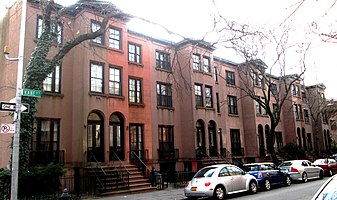
Green-Wood Cemetery is a 478-acre (193 ha) cemetery in the western portion of Brooklyn, New York City. The cemetery is located between South Slope/Greenwood Heights, Park Slope, Windsor Terrace, Borough Park, Kensington, and Sunset Park, and lies several blocks southwest of Prospect Park. Its boundaries include, among other streets, 20th Street to the northeast, Fifth Avenue to the northwest, 36th and 37th Streets to the southwest, Fort Hamilton Parkway to the south, and McDonald Avenue to the east.

Cobble Hill is a neighborhood in the northwestern portion of the New York City borough of Brooklyn. A small neighborhood comprising 40 blocks, Cobble Hill sits adjacent to Brooklyn Heights to the north, Boerum Hill to the east, Carroll Gardens to the south, and the Columbia Street Waterfront District to the west. It is bounded by Atlantic Avenue (north), Court Street (east), Degraw Street (south) and the Brooklyn Queens Expressway (west). Other sources add to the neighborhood a rectangle bounded by Wyckoff Street on the north, Hoyt Street on the east, Degraw Street on the south, and Court Street on the west.
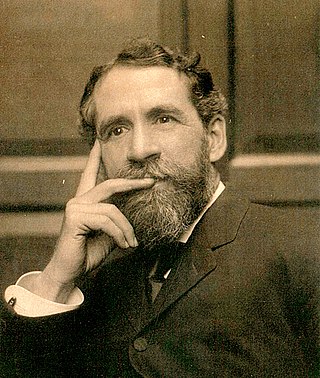
William Bunker Tubby was an American architect who was particularly notable for his work in New York City.

The Church of the Ascension is an Episcopal church in the Diocese of New York, located at 36–38 Fifth Avenue and West 10th Street in the Greenwich Village neighborhood of Manhattan New York City. It was built in 1840–41, the first church to be built on Fifth Avenue and was designed by Richard Upjohn in the Gothic Revival style. The interior was remodeled by Stanford White in 1885–88.
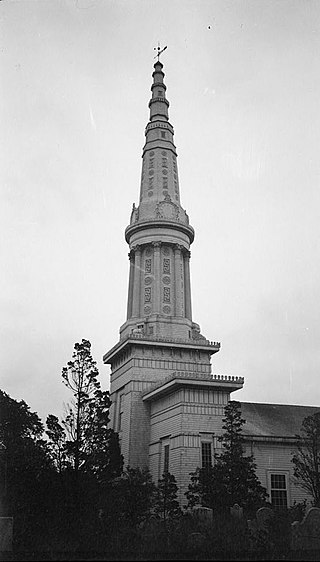
First Presbyterian Church in Sag Harbor, New York, also known as Old Whaler's Church, is a historic and architecturally notable Presbyterian church built in 1844 in the Egyptian Revival style. The church is Sag Harbor's "most distinguished landmark." The facade has been described as "the most important (surviving) example of Egyptian revival style in the United States," and "the best example of the Egyptian Revival style in the U.S. today.
Minard Lafever (1798–1854) was an American architect of churches and houses in the United States in the early nineteenth century.
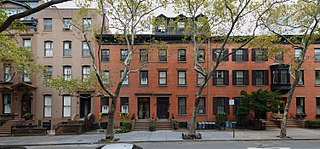
The Brooklyn Heights Historic District is a historic district that comprises much of the Brooklyn Heights neighborhood of Brooklyn, New York City. It was named a National Historic Landmark in January, 1965, designated a New York City Landmark in November, 1965, and added to the National Register of Historic Places in October, 1966.

Rose Hill Mansion is a historic house museum on New York State Route 96A in Fayette, New York. Built in 1837 on a site overlooking Seneca Lake, it is one of the nation's finest examples of monumental residential Greek Revival architecture. The property was declared a National Historic Landmark in 1986. It is now owned and operated by Historic Geneva, formerly the Geneva Historical Society, and is open for tours from May to October.

The John Street United Methodist Church – also known as Old John Street Methodist Episcopal Church – located at 44 John Street between Nassau and William Streets in the Financial District of Manhattan, New York City was built in 1841 in the Georgian style, with the design attributed to William Hurry and/or Philip Embury. The congregation is the oldest Methodist congregation in North America, founded on October 12, 1766 as the Wesleyan Society in America.
The Second Unitarian Church in Brooklyn was a historic church in Cobble Hill, Brooklyn, New York City. Built from 1857 to 1858, it was demolished in 1962. The Church became known as a prominent cultural center in Brooklyn. One of the church's members, Mary White Ovington, co-founded the NAACP and the church was an abolitionist hub.

The Polhemus Memorial Clinic in Cobble Hill, Brooklyn, New York City was built in 1897 as an extension of a hospital for the poor on the corner of Henry and Amity streets. It was officially inaugurated January 5, 1898. Throughout most of its lifetime, 1897 to July 2008, it was part of the Long Island College Hospital (LICH). Joseph Korom, the author of The American Skyscraper (2008), considers the eight-story tower to be the first skyscraper hospital ever built. The clinic and adjacent row houses were designated part of the Cobble Hill Historic District in 1988.

Emmanuel Baptist Church is a Baptist megachurch in the Clinton Hill neighborhood of Brooklyn, New York, on the northwest corner of Lafayette Avenue and St. James Place, affiliated with the American Baptist Churches USA. The attendance is 2,200 peoples. The senior pastor is Anthony L. Trufant.

The Huntington Street Baptist Church is a historic Baptist Church meeting house at 29 Huntington Street in New London, Connecticut. Built in 1843 by John Bishop, who also designed it, it is one of the last major examples of Greek Revival architecture to be built in the city. The church was built by a Universalist congregation and then purchased by a Baptist one. The building was listed on the National Register of Historic Places in 1982. As of 2017, the church is still in use as a Baptist house of worship.
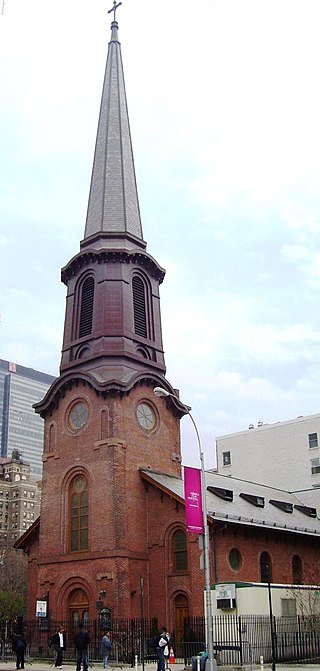
The Church of the Holy Apostles is an Episcopal parish located at 296 Ninth Avenue at 28th Street in the Chelsea neighborhood of Manhattan, New York City. Its historic church building was built from 1845 to 1848, and was designed by New York architect Minard Lafever. The geometric stained-glass windows were designed by William Jay Bolton. The church faces Chelsea Park across 9th Avenue. The building is a New York City landmark and on the National Register of Historic Places.

The Metropolitan Baptist Church, located at 151 West 128th Street on the corner of Adam Clayton Powell Jr. Boulevard in the Harlem neighborhood of Manhattan, New York City, was originally built in two sections for the New York Presbyterian Church, which moved to the new building from 167 West 111th Street. The chapel and lecture room were built in 1884-85 and were designed by John Rochester Thomas, while the main sanctuary was constructed in 1889-90 and was designed by Richard R. Davis, perhaps following Thomas's unused design. A planned corner tower was never built.

Hanson Place Seventh-day Adventist Church, is an historic church at 88 Hanson Place between South Oxford Street and South Portland Avenue in the Fort Greene neighborhood of Brooklyn, New York City, which was built in 1857-60 as the Hanson Place Baptist Church. It was designed by George Penchard in the Early Romanesque Revival style. The building, which is constructed of brick on a brick foundation covered in stucco, features an entrance portico topped by a steeply pitched pediment supported by four Corinthian columns, while the side facade on South Portland features pilasters. The building's interior and exterior were restored in the 1970s. It has been a Seventh-day Adventist church since 1963.

The Lefferts-Laidlaw House is a historic villa located in the Wallabout neighborhood of Brooklyn in New York City, United States. Built around 1840, the house is a two-story frame building in the temple-fronted Greek Revival style.
This is a timeline and chronology of the history of Brooklyn, New York. Brooklyn is the most populous of New York City's boroughs, and was settled in 1646.
John Street is a street in Lower Manhattan. It runs north to south through the Financial District. It is one of the oldest streets in the city. Long associated with maritime activity, the street ran along Burling Slip. The slip was filled in around 1840, and the street widened. Besides a wharf, warehouse, and chandlery, the city's first permanent theatre, and the first Methodist congregation in North America were located on John Street. It was also the site of a well-known pre-Revolutionary clash between the Sons of Liberty and British soldiers, pre-dating the Boston Massacre by six weeks.
